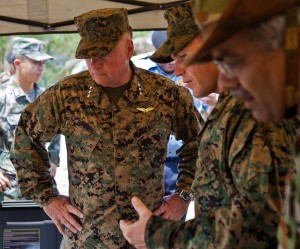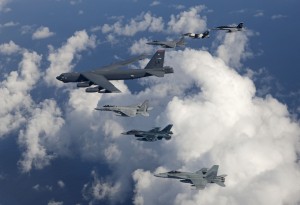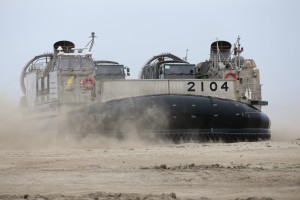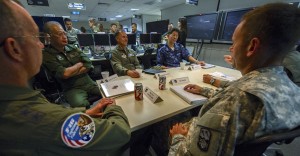2014-03-25 by Ed Timperlake and Robbin Laird
The image of the Marines fighting in Guadalcanal or the US carriers fighting their way through the Japanese fleet in the Pacific are core images for war in the Pacific burnt deeply in the memory of Americans.
The challenges are different this time around but a new generation of Pacific warriors is being trained and shaped for missions central for Pacific defense and for the protection of US interests and the security of Americans living in the homeland.
There are clear links between tradition and the future such as when one visits the headquarters of the USMC in the Pacific.
The HQ building is named for HM Smith or “Howling Mad” Smith of Guadalcanal fame. Now those Marines working in the HQ building look out onto a Pacific with threats from both the PRC and North Korea facing them, and various challenges across the spectrum of warfare throughout a region very large, and very complex.

The recent search for the missing Malaysian airliner reminds us of the vastness of the Pacific and the challenges of operating in such a vast region. Covering a territory which covers so much of the earth’s surface and with thousands of islands present a tapestry of operational complexity.
This is no place for amateurs.
As Admiral Nimitz confronted the last century’s challenges he concluded a core lesson for this century’s Pacific warriors:
“Having confronted the Imperial Japanese Navy’s skill, energy, persistence, and courage, Nimitz identified the key to victory: ‘training, TRAINING and M-O-R-E T-R-A-I-N-I-N-G.’ as quoted in Neptunes’s Inferno, The U.S. Navy at Guadalcanal (James D. Hornfischer)”
The US and its core allies are shaping new capabilities to deal with the various threats and challenges in the Pacific in the time of the Asian century. Flexibility in operations and agility in inserting force with a proper calibration of effect will be enhanced as new systems come on line in the years ahead: the Royal Australian Air Force (RAAF) combination JSTRS and AWACS platform (remember the E-10 we did not buy) Wedgetail, the KC-30A (remember the advanced tanker developed for the USAF being operated by the RAAF and soon by the Singapore Air Force, 11 to be clear), the F-35 (where there are as many allied aircraft as US aircraft coming to the region), the USS Ford, the USS America, new missiles, the Osprey in the hands of the US and its allies, etc.

But these systems will have the proper effect only in the hands of skilled warriors.
And in this century this will mean not only the US training effectively but doing so from the ground up with its core allies and partners.
Recently, in an interview with members of the PACAF staff the growing salience of multinational exercises and training for the core competencies of the USAF and the joint force was underscored with regard to Red Flag 2014:
As one participant put it:
Our role as a facilitator is growing in broadening the engagement opportunities for allies to work together.
A good image of the change is that an Aussie Wedgetail was doing Command and Control for US, Japanese and South Korean jets at the recent Red Flag exercise.
And, for the first time, South Korean jets crossed through Japanese air space to come to fly with the participants in Red Flag.
Indeed, the ability of allies to work together in such a manner is a key part of the deterrence in depth strategy necessary to ensure the peace in a challenging Pacific region.
As Lt. General Robling, the Commanding General for the USMC in the Pacific put it in a recent interview:
It’s not about just building relationships in the region. It is about collective security in the region.
To build out collective security requires in part for us to engage in process of building out partner capacity, and working convergent capacities to shape effective and mutually beneficial relationships underlying the evolution of collective security.
Our working relationship with Australia is a case in point. Even though they, they see themselves as an island continent, they’ve really got to defend themselves much more forward than just waiting for threats to arrive.. And with the size of their force, they wouldn’t be able to do that by themselves. They would have to be a part of a, a collective security effort and ally with the US and other allies in the region in order to get more effective forward operating defense capability.
That’s why it’s important for us that they are buying JSF. That’s why it’s important that they have a Wedgetail. By having the two, they will combine an amazing airborne command and control capability with features of the JSF that can, that can increase their regional reach.
With the JSF, that can, that can take its sensors and pull in a lot of things that are happening from, a significant distance into a Wedgetail that’s flying off the coast of Australia. It makes perfect sense for them.
And when you have other countries like Japan buying the same types of military hardware, Singapore buying the same types of military hardware, the U.S. that’s forward deployed with similar hardware, it makes for a collective security capability that has a lot of depth.
I like the term deterrence and depth because that’s exactly what it is. It’s not about defense and depth. It’s about deterring and, and influencing others behavior so they, they comply with international norms.
The equipment is crucial; the technology is essential; sustainability over the vast distances of the Pacific a sine qua non of operational success.
But convergent modernization works only if there is in Admiral Nimitz’s words: “Training, training and more training.”

This point was emphasized throughout during a recent visit to MARFORPAC, PACAF and in Australia. It is clearly understood by the US forces in the region and our allies that collaborative efforts and effective joint forces do not happen by chance; you train to gain your tactical and strategic advantages.
There are two significant components of a nation’s military force that must be understood and focused on at the highest levels of a nation’s national military command. It is very simple to say and hard to execute; technology has to be available but it also had to be successfully understood and employed.
Just the word “available” carries with it significant operational challenges.
Simple numerical comparisons, and Orders of Battle, are useful and helpful to understand a strategic balance but can ignore important quantitative and qualitative factors.
For example, just counting force comparisons of total inventories can leave out essential considerations of regional deployments and U.S. alliance responsibilities. In addition, static comparisons may ignore the technological imperative affecting both the quality and quality of continuous weapon systems modernization initiatives.
On the human factor side, the measure of “successfully understood and employed” is the greatest challenge until actual combat. A nation has various cultural factors that impact on the selection process of their warriors. The best military is always built on the principle of meritocracy, promotion “up or out” is not just a slogan but one of the most important factors in building the critical intangible question;
Can a force at all ranks fight and win?
Out of a nation’s youth, there needs to be a selection process, then a basic training process progressing to combat training and comprehension of tactics and then continuous proficiency training. This really has not changed since armies came into existence and it always takes moral courage and good judgment by leaders who are not afraid of leaving many behind.
Embrace allies and always assume a reactive enemy can help in the effort to develop the necessary technology to try and mitigate any advantages. But with the worldwide proliferation of weapons even a second or third world nation might have state-of-the art systems. This enhances the importance of competence and preparation.

A country’s military may have figured out all of the above but is going down a warfighting path that is often referred as asymmetric. “Asymmetric” is often thrown as an insightful debating point when it is just a simple way of saying at all times be cautious of the famous intelligence community dictum, avoid “mirror imaging” Of course asymmetric works both ways for opponents. One side maybe “asymmetric” and totally misdirected in terms of what is required for mission success. The problem is that mistakes will only be found out for real when the first round goes down range.
The other debating point often used is “disruptive technology” often a proposed deus ex machina that can be raised to take counsel of ones fears. The atomic bomb was a major “disruptive technology.” Being very specific the world wide scientific community has many, many papers in prestigious journals that capture trends of research that can lead to the next generation of “disruptive technology.” But briefing slides only kill audiences; they are not effective in battle.
Caution about the next disruptive technology is well taken, but it is often well-known globally, and it is more a race to actually putting the system into play and figuring out how to use it. This is why the cautious weapons testers holding back warriors get their hands on new platforms and figuring out what the path to upgrading them can be a clear problem.
Technologies are not disruptive in and of themselves.
Their effectiveness to become disruptively decisive will depend on the skill of the force.

If we were waiting for the weapons testers, the Osprey revolution underway in the USMC would be an idea, not a reality.
Across the Pacific the US has coined a term the Air/Sea Battle, but it is not just a set of briefing slides. It is about real warriors figuring out how to get the kind of innovation and integration in the joint forces which can position the US and its allies to shape an effective Pacific defense strategy.
As Navy Captain Pat Connelly, currently the liaison from PACFLT to PACAF, underscored in a recent interview:
Basically, the Air Force and the Navy have been working at supporting one another for a long time. Air-Sea Battle is really just the next phase in codifying and further developing what we are already doing.
We are looking to enhance cross-domain synergy and to do a better job in coordinating and integrating the sensors and shooters which the US Army, USAF, USN and USMC can bring to bear on defense problems, and to work more effectively with allies contributing capabilities as well to the broader Pacific defense challenges.
It is Admiral Nimitz who must be listened to and not the “cubicle commandoes” in the DC “word tanks” to define the reality of air-sea battle. We report regularly on the words and actions of the military and civilians in the Pacific of all ranks in many nations that can give Americans the true picture of the state of the art of the 21st century Pacific warriors because that is who they are.
As Putin and his soldiers redraw the map of Europe, it is useful to remember that the Cold War was won in part by the US military and civilian leadership working with our closest allies in Europe in the effort to reshape US and allied forces to put in place a military approach which took the effectiveness of the Soviet military right off of the table.
It was clear to the last great military leader of the Soviet Union, Marshal Ogarkov, that the new air-land battle doctrine, equipment and training made the legacy Soviet forces a diminishing asset and argued for his own scientific-technological revolution to get ahead of the curve.
Fortunately, with the Farewell Affair built around a partnership between President’s Reagan and Mitterrand, the Soviets lost inside access to the evolution of US and allied military technologies. Their ability to compete severely reduced, the military underpinnings of credible Soviet military dominance in Europe was ending.
This is a lesson, which the PRC might well need to learn as well.
A remarkable US Army leader towards the end of his life indicated the crucial role which the reshaping of the US and allied militaries under the influence of Air-Land battle played in reshaping the strategic balance in Europe.
General Starry later told Army historians that in his view the three most important differences between the 1976 and 1982 versions of FM 100-5 were that the later version included a set of operational concepts that put us back on the nuclear and chemical battlefield, thus ensuring that an enemy’s surprise or first use of such weaponry would not enable him to win the war thereby; that it recognized and addressed the importance of attacking the enemy’s second and following echelons; and that it dealt with the balance between firepower and maneuver.
Re-shaping the doctrine, re-equipping the force, working a close cross-modernization process with allies, and “training, training and more training” reshaped the NATO forces facing the Warsaw Pact and contributed to the erosion of the Soviet Union.
The Pacific today is as demanding as the 1980s for challenges and dynamics of change.
As Putin has made clear by his latest actions, history is on the move once more. The challenge is to prepare, be ready and to provide for the kind of deterrence, which informs adversaries in advance that staring down the United States and its allies is not worth the effort.

